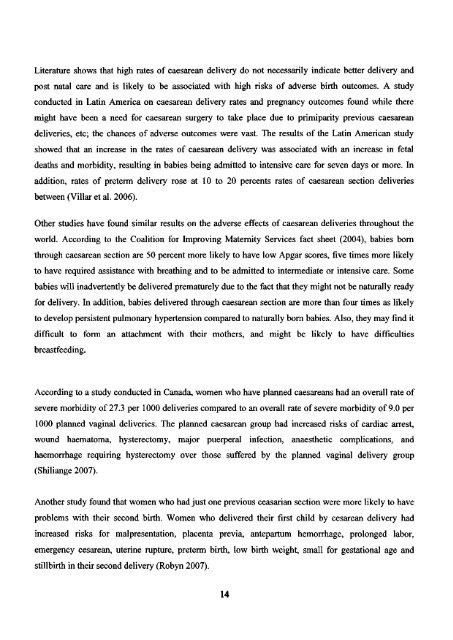an examination of the role of antenatal care attendance in ...
an examination of the role of antenatal care attendance in ...
an examination of the role of antenatal care attendance in ...
Create successful ePaper yourself
Turn your PDF publications into a flip-book with our unique Google optimized e-Paper software.
Literature shows that high rates <strong>of</strong> caesare<strong>an</strong> delivery do not necessarily <strong>in</strong>dicate better delivery <strong>an</strong>d<br />
post natal <strong>care</strong> <strong>an</strong>d is likely to be associated with high risks <strong>of</strong> adverse birth outcomes. A study<br />
conducted <strong>in</strong> Lat<strong>in</strong> America on caesare<strong>an</strong> delivery rates <strong>an</strong>d pregn<strong>an</strong>cy outcomes found while <strong>the</strong>re<br />
might have been a need for caesare<strong>an</strong> surgery to take place due to primiparity previous caesare<strong>an</strong><br />
deliveries, etc; <strong>the</strong> ch<strong>an</strong>ces <strong>of</strong> adverse outcomes were vast. The results <strong>of</strong> <strong>the</strong> Lat<strong>in</strong> Americ<strong>an</strong> study<br />
showed that <strong>an</strong> <strong>in</strong>crease <strong>in</strong> <strong>the</strong> rates <strong>of</strong> caesare<strong>an</strong> delivery was associated with <strong>an</strong> <strong>in</strong>crease <strong>in</strong> fetal<br />
deaths <strong>an</strong>d morbidity, result<strong>in</strong>g <strong>in</strong> babies be<strong>in</strong>g admitted to <strong>in</strong>tensive <strong>care</strong> for seven days or more. In<br />
addition, rates <strong>of</strong> preterm delivery rose at 10 to 20 percents rates <strong>of</strong> caesare<strong>an</strong> section deliveries<br />
between (Villar et al. 2006).<br />
O<strong>the</strong>r studies have found similar results on <strong>the</strong> adverse effects <strong>of</strong> caesare<strong>an</strong> deliveries throughout <strong>the</strong><br />
world. Accord<strong>in</strong>g to <strong>the</strong> Coalition for Improv<strong>in</strong>g Maternity Services fact sheet (2004), babies born<br />
through caesare<strong>an</strong> section are 50 percent more likely to have low Apgar scores, five times more likely<br />
to have required assist<strong>an</strong>ce with breath<strong>in</strong>g <strong>an</strong>d to be admitted to <strong>in</strong>termediate or <strong>in</strong>tensive <strong>care</strong>. Some<br />
babies will <strong>in</strong>advertently be delivered prematurely due to <strong>the</strong> fact that <strong>the</strong>y might not be naturally ready<br />
for delivery. In addition, babies delivered through caesare<strong>an</strong> section are more th<strong>an</strong> four times as likely<br />
to develop persistent pulmonary hypertension compared to naturally born babies. Also, <strong>the</strong>y may f<strong>in</strong>d it<br />
difficult to form <strong>an</strong> attachment with <strong>the</strong>ir mo<strong>the</strong>rs, <strong>an</strong>d might be likely to have difficulties<br />
breastfeed<strong>in</strong>g.<br />
Accord<strong>in</strong>g to a study conducted <strong>in</strong> C<strong>an</strong>ada, women who have pl<strong>an</strong>ned caesare<strong>an</strong>s had <strong>an</strong> overall rate <strong>of</strong><br />
severe morbidity <strong>of</strong> 27.3 per 1000 deliveries compared to <strong>an</strong> overall rate <strong>of</strong> severe morbidity <strong>of</strong> 9.0 per<br />
1000 pl<strong>an</strong>ned vag<strong>in</strong>al deliveries. The pl<strong>an</strong>ned caesare<strong>an</strong> group had <strong>in</strong>creased risks <strong>of</strong> cardiac arrest,<br />
wound haematoma, hysterectomy, major puerperal <strong>in</strong>fection, <strong>an</strong>aes<strong>the</strong>tic complications, <strong>an</strong>d<br />
haemorrhage requir<strong>in</strong>g hysterectomy over those suffered by <strong>the</strong> pl<strong>an</strong>ned vag<strong>in</strong>al delivery group<br />
(Shili<strong>an</strong>ge 2007).<br />
Ano<strong>the</strong>r study found that women who had just one previous ceasari<strong>an</strong> section were more likely to have<br />
problems with <strong>the</strong>ir second birth. Women who delivered <strong>the</strong>ir first child by cesare<strong>an</strong> delivery had<br />
<strong>in</strong>creased risks for malpresentation, placenta previa, <strong>an</strong>tepartum hemorrhage, prolonged labor,<br />
emergency cesare<strong>an</strong>, uter<strong>in</strong>e rupture, preterm birth, low birth weight, small for gestational age <strong>an</strong>d<br />
stillbirth <strong>in</strong> <strong>the</strong>ir second delivery (Robyn 2007).<br />
14

















